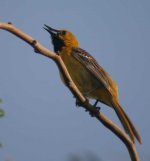Michael, can I bring your attention to the National Audubon Society Field Guide to North American Birds, (Western Region) photograph 588 text page 760.
In addition, there are photographs and descriptions of female Scott's on the web,
" Females are, on average, smaller than the males. Adult females have olive-gray under parts and top of the head with dark streaks on the back. There is no brown present on the body. The body color becomes yellowish on the rump and upper tail coverts. They also have two wing bars, as opposed to the male's one wing bar. The female's throat is sometimes spotted, clouded, or washed with black. Old females usually have a completely black throat. Immature females are duller in color, without a trace of black. (Bailey, 1928; Brandt, 1951; Ligon, 1961; Phillips, 1964)"
That would tend to contradict your statement to an extent.
When enlarging your supplied photograph, a second wingbar is there to an extent on some of the coverts.
http://www.mbr-pwrc.usgs.gov/id/fra...ges/h5050p2.jpg for a poor photo of a juv Hooded.
Best regards
Malky, allways open for ID discussions.
Today 11:29





